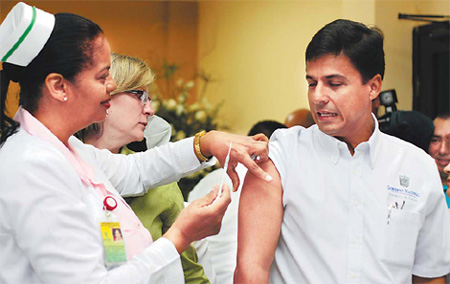Science and Health
WHO: Immunity to H1N1 on the rise
(China Daily)
Updated: 2010-01-09 10:20
 |
Large Medium Small |
GENEVA: Southern hemisphere countries struck by the H1N1 flu last year are now broadly protected against new infections, the World Health Organization said on Friday.
|
 A man receives the H1N1 vaccine in Panama City on Wednesday. The Panama's Ministry of Health began a massive vaccination campaign against the H1N1 flu virus throughout the country with the first purchase of 300,000 doses of the vaccine. [Agencies] |
In its latest assessment of the virus, the WHO signaled the worst of this year's northern hemisphere flu season may be over for most countries, with sickness levels declining in much of Europe and in North America, where the pandemic first emerged.
The H1N1 virus - declared a global pandemic by the United Nations health agency in June -- has killed up to 12,800 people, according to the WHO's toll of lab-confirmed cases.
Disease activity peaked in October in Mexico, the United States and Canada, with flu infections now below the historical seasonal baseline after a big surge in autumn and early winter.
And in southern hemisphere nations, where H1N1 was prolific last year, the WHO said the flu virus was now spreading less easily among people who were already exposed to it.
"In temperate regions of the southern hemisphere, sporadic cases of pandemic influenza continued to be reported without evidence of sustained community transmission," it said.
"This suggests that the level of population immunity in areas that experienced intense, high-level transmission during a winter season is high enough to prevent sustained transmission from returning during the summer when the virus is less transmissible."
The WHO did not say whether those countries would be better protected for their next winter season, typically when flu viruses spread fastest and easiest.
WHO Director-General Margaret Chan said last week it would take another six to 12 months for the first pandemic in more than 40 years to run its course.
She said pregnant women, young people and those with chronic medical conditions like asthma should continue to take special precautions against the virus.
Mongolia is the first developing country to receive donated H1N1 vaccine doses, with 100,000 doses delivered to the country on Thursday, WHO spokesman Gregory Hartl told a briefing.
Azerbaijan was due to receive 170,000 doses later on Friday.
New strains
The declining wave of pandemic H1N1 flu is likely to be followed by new, unknown strains of seasonal flu which health authorities must watch carefully to devise protection measures, European flu experts said on Friday.
The European Centre for Disease Prevention and Control warned that flu viruses "never stand still" and said governments should not relax H1N1 flu vaccination programs, but remain on guard for possible changes in the virus and new strains.
"The historical pattern of human influenza is that after pandemics, the world experiences a new mix of viruses," the center's flu expert Angus Nicoll wrote in the Eurosurveillance scientific journal.
In a telephone interview, Nicoll said although signs from many parts of Europe and the United States suggest circulation of H1N1 is declining, it is still too early to say the pandemic is over.
He noted that the virus responsible for the last pandemic in 1968-70 became more easily transmitted between its first and second winter, so that there were more cases and deaths in the second winter (1969-70) in at least two European countries.
An earlier pandemic in 1957-58 also declined before Christmas 1957, but then came back to cause a rise in flu-related deaths in the new year of 1958.
In the current pandemic, new infections of H1N1 flu have fallen sharply in recent weeks and some governments have been left with an oversupply of vaccines ordered to protect their populations against the virus that emerged last March.
Uptake of the vaccine has been limited in some countries and advice from medical experts that one dose is enough to protect against the virus, rather than the two originally anticipated, means some governments have more than they need.
Nicoll said pandemic H1N1 flu had not completely halted other flu viruses in recent months, but had been the predominant strain, meaning that its decline could open the way for a new mix of viruses known as inter-pandemic or seasonal flus.
He said governments should continue to urge people to get vaccinated against H1N1, since the shots were "the most potent countermeasure" for any human flu.
"The rule with influenza, pandemic and inter-pandemic, is to maintain vigilance and expect the unexpected," he said.
Reuters












